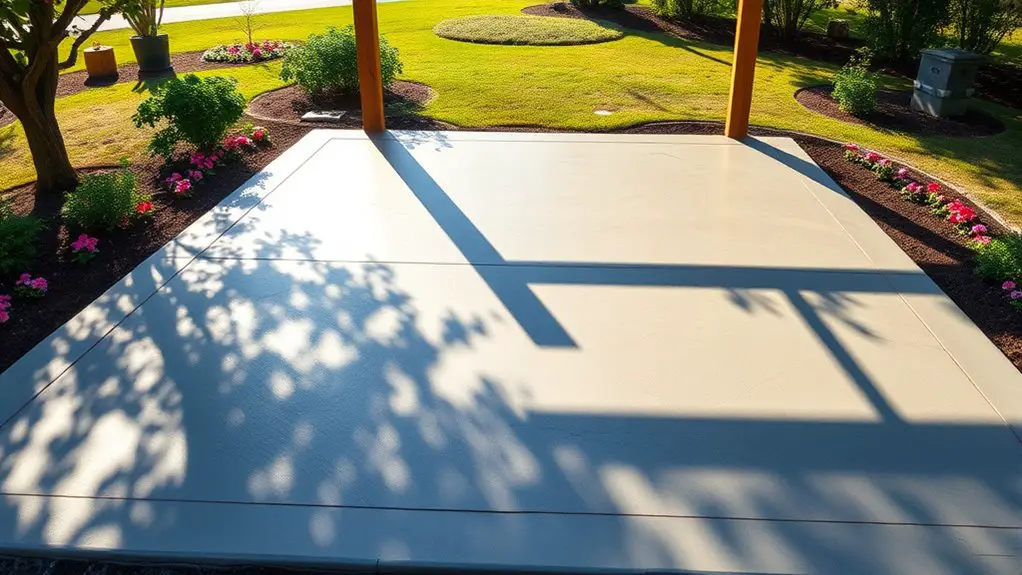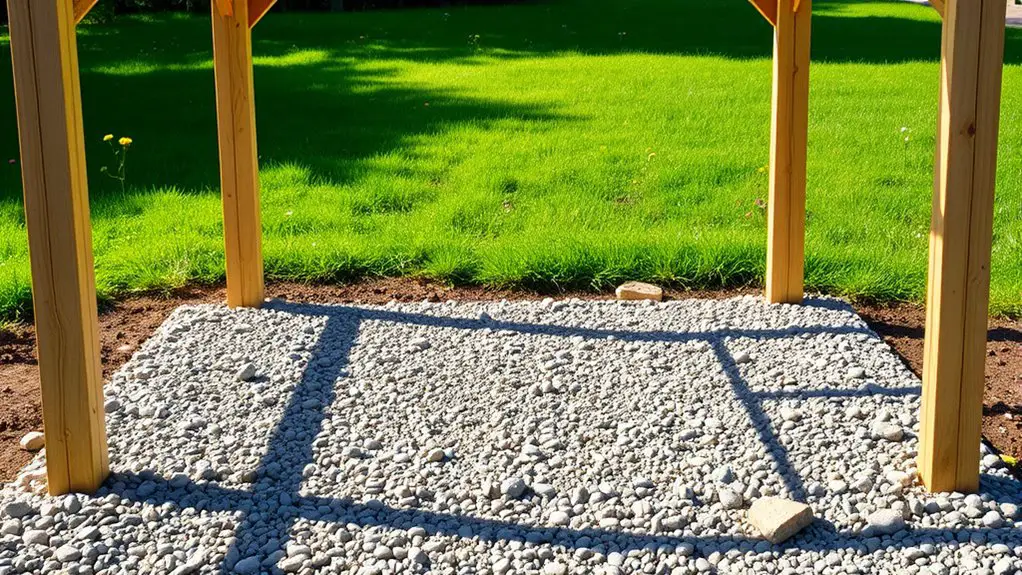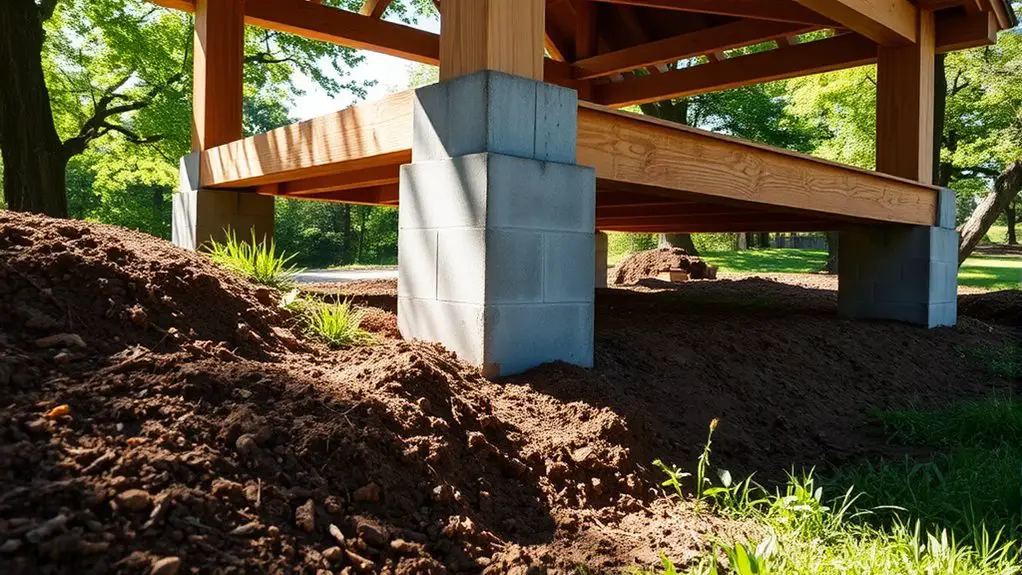When constructing a gazebo, consider these foundation options for best results. Concrete slab foundations provide excellent durability with proper curing. Paver or brick bases offer aesthetic versatility and effective drainage. Gravel foundations are cost-effective and capable of handling various terrains, while wooden decking combines elegance and support. Finally, pier and beam foundations cater to unstable soil conditions, ensuring stability and ventilation. Explore further to discover the pros and cons of each option for your specific needs.
Concrete Slab Foundations

A concrete slab foundation is one of the most popular options for gazebo construction due to its durability and stability. When you choose this method, it’s essential to take into account slab thickness, typically ranging from 4 to 6 inches, depending on load requirements and soil conditions. A thicker slab offers better support and longevity, ensuring your gazebo withstands the test of time.
Concrete curing is another important aspect. Proper curing allows the concrete to gain strength and resist cracking, which is necessary for maintaining structural integrity. You’ll need to keep the slab moist for at least a week after pouring, using curing compounds or wet coverings.
Paver or Brick Bases
Paver and brick bases offer an attractive and versatile alternative for gazebo foundations, combining aesthetic appeal with functionality. When you consider paver installation, you’ll find that it allows for easy customization in design, enabling you to match your gazebo’s style and your landscaping preferences. The interlocking nature of pavers provides stability, while their permeability helps with drainage, minimizing water pooling around your gazebo.
Brick durability is another significant advantage. High-quality bricks can withstand harsh weather conditions and resist cracking over time, ensuring your gazebo remains supported over the years. Additionally, both pavers and bricks require minimal maintenance, making them ideal for those who value freedom from frequent upkeep.
Ultimately, choosing a paver or brick base means investing in a solid foundation that enhances your outdoor space while providing the durability and aesthetic you desire. It’s a decision that balances beauty with practicality for your gazebo project.
Gravel Foundations

While paver and brick bases provide a solid foundation option, gravel foundations also present a practical choice for gazebo construction. Gravel offers several advantages that cater to your need for stability and effective drainage.
- Gravel drainage: The porous nature of gravel allows water to flow through, preventing puddles and reducing erosion around your gazebo.
- Gravel stability: When compacted properly, gravel can create a stable surface that supports the weight of the structure while allowing for easy adjustments if needed.
- Cost-effectiveness: Gravel is often more affordable than other foundation options, making it a budget-friendly choice without sacrificing quality.
Incorporating gravel into your gazebo foundation not only enhances durability but also aligns with a desire for a low-maintenance, versatile solution. It’s a smart option if you’re looking to balance functionality with aesthetic appeal while ensuring your gazebo remains grounded. Additionally, gravel foundations can be a great choice in ground conditions where traditional options may not be feasible, providing an adaptable solution for various terrains.
Wooden Decking
When considering a foundation for your gazebo, wooden decking offers a blend of aesthetic appeal and functional support that can enhance your outdoor space. The choice of decking materials plays an essential role in durability and maintenance. Hardwoods like cedar or redwood provide natural resistance to decay, while pressure-treated lumber is cost-effective and widely available.
For peak performance, you’ll want to employ effective installation techniques. Begin by ensuring a level base for your structure, using concrete footings as necessary to prevent settling. Proper spacing between boards is essential to allow for drainage and expansion. Additionally, applying a weather-resistant sealant can prolong the life of your decking. It is also important to consider the size options for gazebos to ensure that your foundation adequately supports the structure.
Ultimately, wooden decking not only supports your gazebo but also complements your landscape, creating an inviting area that connects you with nature. With careful selection and installation, it can be a long-lasting foundation choice for your outdoor retreat.
Pier and Beam Foundations

Pier and beam foundations provide a robust and adaptable option for gazebo construction, especially in areas with unstable soil conditions. This method enhances load distribution, ensuring your structure remains stable over time. When considering pier installation, it’s essential to follow specific guidelines to maximize effectiveness.
- Versatility: Suitable for various soil types, offering freedom in location choice.
- Ventilation: Allows for air circulation beneath the gazebo, preventing moisture buildup.
- Elevation: Raises your gazebo, protecting it from flooding or water damage.
Frequently Asked Questions
How Do I Choose the Right Foundation for My Gazebo Size?
To choose the right foundation for your gazebo size, consider various foundation materials that match the gazebo styles you prefer. Guarantee stability and durability by selecting materials suited to your region’s climate and soil conditions.
What Is the Average Cost of Gazebo Foundation Options?
The average cost of gazebo foundation options varies widely, depending on foundation materials and installation costs. You’ll typically spend between $500 to $2,500, factoring in labor, material quality, and local pricing trends.
Can I Build a Gazebo on Uneven Ground?
Yes, you can build a gazebo on uneven ground. However, you’ll need effective leveling techniques and thorough ground preparation to guarantee stability and safety. Ignoring these steps could lead to structural issues or safety hazards.
How Do I Maintain My Gazebo Foundation Over Time?
To maintain your gazebo foundation over time, perform regular foundation inspections and address any issues. Seasonal maintenance, like clearing debris and checking for erosion, guarantees stability and prolongs the life of your structure effectively.
Are There Any Permits Required for Gazebo Foundation Construction?
Did you know over 60% of homeowners overlook permit requirements for outdoor structures? It’s essential to check local foundation regulations before construction, as these permits guarantee safety, compliance, and ultimately protect your investment in the long run.

